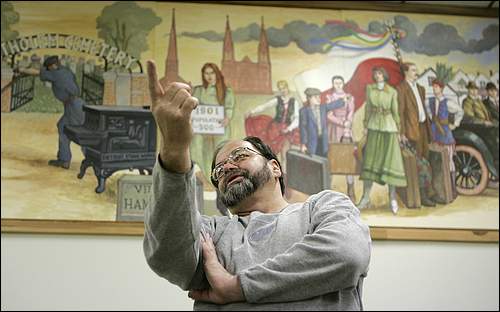|
|
Thomas Cervenak, executive director of People's Community Services of Metropolitan Detroit, discusses the mural that illustrates events in Hamtramck that date to its 18th-century establishment. The seven-year effort of Denby High School art teacher Dennis Orlowski and youth artists covers 164 feet in the H.I. Mayson-Hamtramck Neighborhood Center.
Mural Honors Heritage Christine Ferretti | / The Detroit News HAMTRAMCK - Barbara Ann Dillon smiled Thursday as she scanned the hand-painted ceiling border that depicts the beloved movie theaters of her childhood. "This really brings back memories," the lifelong Hamtramck resident said. Dillon, 75, visited the H.I. Mayson-Hamtramck Neighborhood Center to see the "History of Hamtramck " mural, which has been in the works for about seven years. The 164-foot mural, painted by Denby High School art teacher Dennis Orlowski and youth artists, was dedicated Thursday. The sprawling $17,000 work captures the evolution of the community from its establishment as a township in 1798 to its birth as a city in 1922. Funded by grants, it features people concocting bathtub gin during the Depression, children dancing the Charleston and the Women's Meat Strike of 1935, when Polish and black housewives picketed butcher shops to end price gouging in black neighborhoods. "This mural will be a source of pride to Hamtramck ," said Tom Cervenak, executive director of People's Community Services, a nonprofit serving low-income Metro Detroit neighborhoods. "It shows how important this city was to the development of the whole region." Jacqueline Byrd, a 20-year employee of the center on Joseph Campau, posed for and is featured in the mural. Byrd's character sits under a tree shelling peas in the northwestern corner of the mural in a blue dress and white apron. "The painter asked me to pose for him I guess he thought I was a good candidate," said Byrd, 59, of Detroit . "It's amazing how he captured al l the different times. "People will learn the history of how things began and what's happening now." Cervenak said the mural represents the "sense of pride" residents have for he 33,000-resident city that historically has been a refuge to German, French, Polish and Middle Eastern immigrants and remains perhaps the most diverse city in Michigan , with 25-plus ethnic groups.
|

